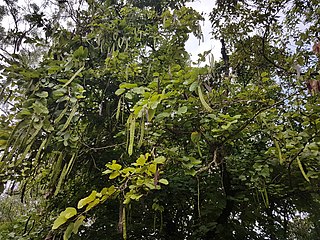
Bauhinia is a large genus of flowering plants in the subfamily Cercidoideae and tribe Bauhinieae, in the large flowering plant family Fabaceae, with a pantropical distribution. The genus was named after the Bauhin brothers Gaspard and Johann, Swiss-French botanists.

Ulmus glabraHudson, the wych elm or Scots elm, has the widest range of the European elm species, from Ireland eastwards to the Ural Mountains, and from the Arctic Circle south to the mountains of the Peloponnese and Sicily, where the species reaches its southern limit in Europe; it is also found in Iran. A large deciduous tree, it is essentially a montane species, growing at elevations up to 1,500 m (4,900 ft), preferring sites with moist soils and high humidity. The tree can form pure forests in Scandinavia and occurs as far north as latitude 67°N at Beiarn in Norway. It has been successfully introduced as far north as Tromsø and Alta in northern Norway (70°N). It has also been successfully introduced to Narsarsuaq, near the southern tip of Greenland (61°N).

Bauhinia × blakeana, commonly called the Hong Kong orchid tree, is a hybrid leguminous tree of the genus Bauhinia. It has large thick leaves and striking purplish red flowers. The fragrant, orchid-like flowers are usually 10 to 15 centimetres across, and bloom from early November to the end of March. Although now cultivated in many areas, it originated in Hong Kong in 1880 and apparently all of the cultivated trees derive from one cultivated at the Hong Kong Botanical Gardens and widely planted in Hong Kong starting in 1914. It is referred to as bauhinia in non-scientific literature though this is the name of the genus. It is sometimes called the Hong Kong orchid. In Hong Kong, it is most commonly referred to by its Chinese name of 洋紫荊 (yèuhng jígīng).
Orchid tree is a common name for several tree species, including:

Bauhinia variegata is a species of flowering plant in the legume family, Fabaceae. It is native to an area from China through Southeast Asia to the Indian subcontinent. Common names include orchid tree and mountain ebony.

Bauhinia purpurea is a species of flowering plant in the family Fabaceae, native to the Indian subcontinent and Myanmar, and widely introduced elsewhere in tropical and subtropical areas of the world. Common names include orchid tree, purple bauhinia, camel's foot, butterfly tree, and Hawaiian orchid tree.

Bauhinia acuminata is a species of flowering shrub native to tropical southeastern Asia. Common names include dwarf white bauhinia, white orchid-tree and snowy orchid-tree. The exact native range is obscure due to extensive cultivation, but probably from Malaysia, Indonesia, and the Philippines.

Erythrina variegata, commonly known as tiger's claw or Indian coral tree, is a species of Erythrina native to the tropical and subtropical regions of eastern Africa, the Indian subcontinent, northern Australia, and the islands of the Indian Ocean and the western Pacific Ocean east to Fiji.
The so-called American Elm cultivar Ulmus americana 'Variegata' was a Belgian clone mentioned by Wesmael in Bulletin de la Fédération des sociétés d'horticulture de Belgique, 1862, as Ulmus americana var. variegataHort. It was marketed by the Baudriller nursery of Angers as U. americana foliis variegatis. Wesmael's herbarium specimens, however, held in the Botanic Garden, Meise, both of his Ulmus americana and of his Ulmus americana var. variegata, do not appear to show American white elm leaves. It is known that nurseries in Europe and America marketed the golden wych elm Ulmus glabra 'Lutescens' as Ulmus americana aurea, and it is likely that Wesmael's Ulmus americana variegata was similarly misnamed, and perhaps derived from a reverting branch of aurea, whose leaves it resembled.
Conopobathra gravissima is a moth of the family Gracillariidae. It is known from India, Indonesia (Java), Malaysia (Selangor), the Bismarck Archipelago, Thailand, South Africa, Kenya, Namibia and Zimbabwe.

Senegalia pennata, is a species of plant which is native to South and Southeast Asia. It is a shrub or small tropical tree which grows up to 5 metres (16 ft) in height. Its leaves are bipinnate with linear-oblong and glabrous pinnules. Its yellowish flowers are terminal panicles with globose heads. The pods are thin, flat and long with thick sutures.

Piliostigma thonningii is a species of flowering plants in the legume family, Fabaceae. It belongs to the subfamily Cercidoideae.

Chiayi City Government is the municipal government of Chiayi City, Taiwan Province, Republic of China.

Lysiphyllum cunninghamii is a species of plant in the family Fabaceae. It is native to northern Australia where it occurs from Western Australia through the Northern Territory to Queensland.

Falcataria falcata, commonly known as the Moluccan albizia, is a species of fast-growing tree in the family Fabaceae. It is native to the Maluku Islands, New Guinea, the Bismarck Archipelago, and the Solomon Islands. It is cultivated for timber throughout South Asian and Southeast Asian countries. This tree is considered to be invasive in Hawaii, American Samoa and several other island nations in the Pacific and Indian Oceans. It reaches about 30 m (100 ft) tall in nature, and has a massive trunk and an open crown.
Streptomyces actinomycinicus is a bacterium species from the genus Streptomyces which has been isolated from soil from a peat swamp forest in the Rayong Province in Thailand.

Piliostigma malabaricum is a small tree species in the family Fabaceae. It was previously placed in the genus Bauhinia, but names changed with reorganisation of the subfamily Cercidoideae and the tribe Bauhinieae.
Streptomyces mimosae is a bacterium species from the genus of Streptomyces which has been isolated from the root of a Mimosa pudica plant in Thailand.
Xylosandrus discolor, is a species of weevil found in Australia, Micronesia, Myanmar, China, India, Sri Lanka, Indonesia, Malaysia, Taiwan and Thailand.
Xyleborus perforans, commonly known as island pinhole borer, is a species of weevil native in the Oriental region through to Australia but shows a cosmopolitan distribution due to introduction to many parts of the world.












